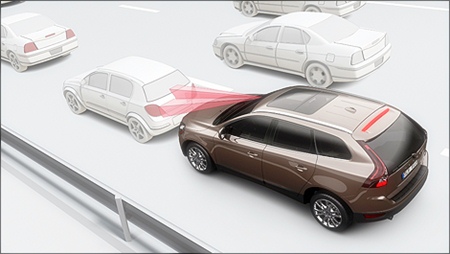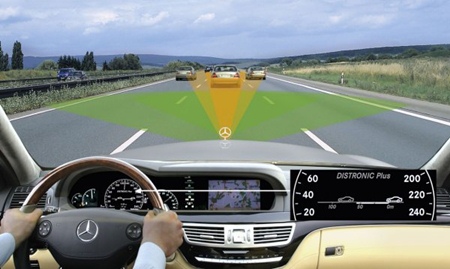The “auto” car is (almost) here, heralding the death knell for driving enthusiasts. The world is getting ready to hand the control of the family car to the computer. You can no longer be trusted! (But can it?)
The technology that is now being offered, as far as anti-collision is concerned, has actually been developed over the last 10 years, but as the modern car becomes more electronic, it has become easier to incorporate the anti-collision technology into the car’s electronics.
Take electronic cruise control for example. This works through the Electronic Control Unit (ECU) and adapts the pre-set road speed to the fuel/air mixture the engine receives. As speed drops, increased fuel/air is called for and the car speeds up. And vice versa when the road speed exceeds the pre-set level. Going downhill, the ECU can even tell the brakes to apply light pressure to bring down and control the road speed.
 Volvo City Safety
Volvo City Safety
So the vehicles have had the ECU ‘smarts’ for some time, and all that is needed, is to hook an anti-collision system in with the cruise control ECU.
The human ‘anti-collision’ model relies on visual interpretation of the distance and previously stored knowledge of how much distance it will need to pull up from that speed. Some of us are better than others at this! There is also the problem that when you leave two car lengths to the car in front, in Thailand that space is very quickly filled with two cars and several motorcycles!
To do this anti-collision calculation electronically is done by using a form of radar. The message comes back to the car to indicate that at the current road speed, there is not enough distance in which to pull up without ‘rear-ending’ the car in front. The ECU can then shut down the fuel/air mixture and instead of just getting the brakes pre-charged, can now apply the brakes (independently from the driver) to slow the car enough to avoid the rear end collision.
 Mercedes Distronic Plus
Mercedes Distronic Plus
Toyota has been developing their concept of this system, which is designed to not only stop rear end collisions, but to stop you running red lights as well (it will never be accepted in Thailand where running red lights is a national pastime).
The system detects other cars, street aids and passers-by as you drive and then sends a signal to the driver if it thinks that you will not be able to stop in time. The signals are received from transmitters placed in street signs, lights, other vehicles and hand held units for pedestrians. It could also go as far as to brake the car if it feels the driver hasn’t realized the lights are on red.
The above system relies on signals transmitted from traffic lights or even people, but there is another way. Bounce the signals back to the receiver unit. This type of system has been developed by Cambridge Consultants Ltd (CCL) in the UK. Called CCL-Softcar, the radar solves the performance and cost issues that have stalled progress in this area – heralding a new generation of smart anti-collision technology capable of meeting the demanding economic goals of the automotive industry.
For those who happily talk about giga-hertz, CCL-Softcar is a pulsed radar system working in the 5.8 GHz band, rather than the 24 or 77 GHz frequencies of alternative approaches. Working at this lower frequency reduces the cost of the components required to build a system, and avoids the time and cost overhead which precision assembly of higher frequency equipment imposes. Just four radar modules and one electronic control unit (ECU) are required to provide 360° protection – further reducing the bill of materials compared with alternative approaches which can require two or more modules to be installed on every side of a vehicle.
So the on-board technology can be developed to be within financial parameters, and that brings us to Volvo, Mercedes and Honda. The Volvo City Safety, Mercedes Distronic Plus, and Honda CMBS use radar systems to mitigate and prevent low speed collisions – which, as a category, make up 75 percent of all motor accidents.
The Volvo City Safety uses laser radar, or LIDAR, to track the distance and speed of the car in front of the driver. The windscreen mounted device renews its calculations 50 times a second, pre-charging the brakes to avoid potential collisions before drivers can even sense the danger.
The system is active at speeds of up to 30 km/h and has a range of up to six meters in front of the car. If a driver fails to activate the brakes before an imminent collision, the City Safety system automatically stops the car, and even steers it out of harms way.
Like the City Safety, the Mercedes Distronic Plus uses a form of radar to maintain safe distance from neighboring cars. However, the two radars on the Distronic Plus are linked to the car’s cruise control, adding an extra level of autonomy to the system. The Distronic Plus operates at speeds of up to 200 km/h, keeping your car in sync with traffic whether it be stop-start gridlock or long stretches of freeway.
The Honda CMBS also uses radar to calculate the distance and speed of the vehicle in front, sending visual and audible warnings to the driver and automatically applying the brakes if a collision is imminent.
While all three systems use radar technology to create impressive, and effective, collision prevention systems, they are also vulnerable to radar’s weaknesses. Weather conditions like fog and rain can undermine its effectiveness, and dirt can obscure the sensor.
One tester who has driven a car fitted with this kind of anti-collision technology found it initially very difficult to stop waving his foot over the brake pedal, but eventually gained enough confidence to allow the car to stop by itself a safe distance from the car in front in city traffic. However, he did find a problem when there was no car stopped in front of him, and if not checked by the human mind, could have sailed blithely through the red light (in fine Thai style). This brings us back to the Toyota system, but the infrastructure costs would be horrendous – and as always, who would pay?




